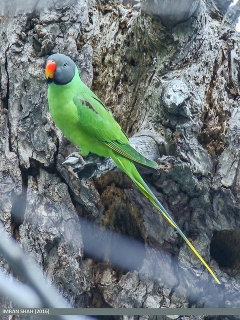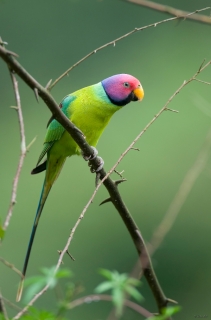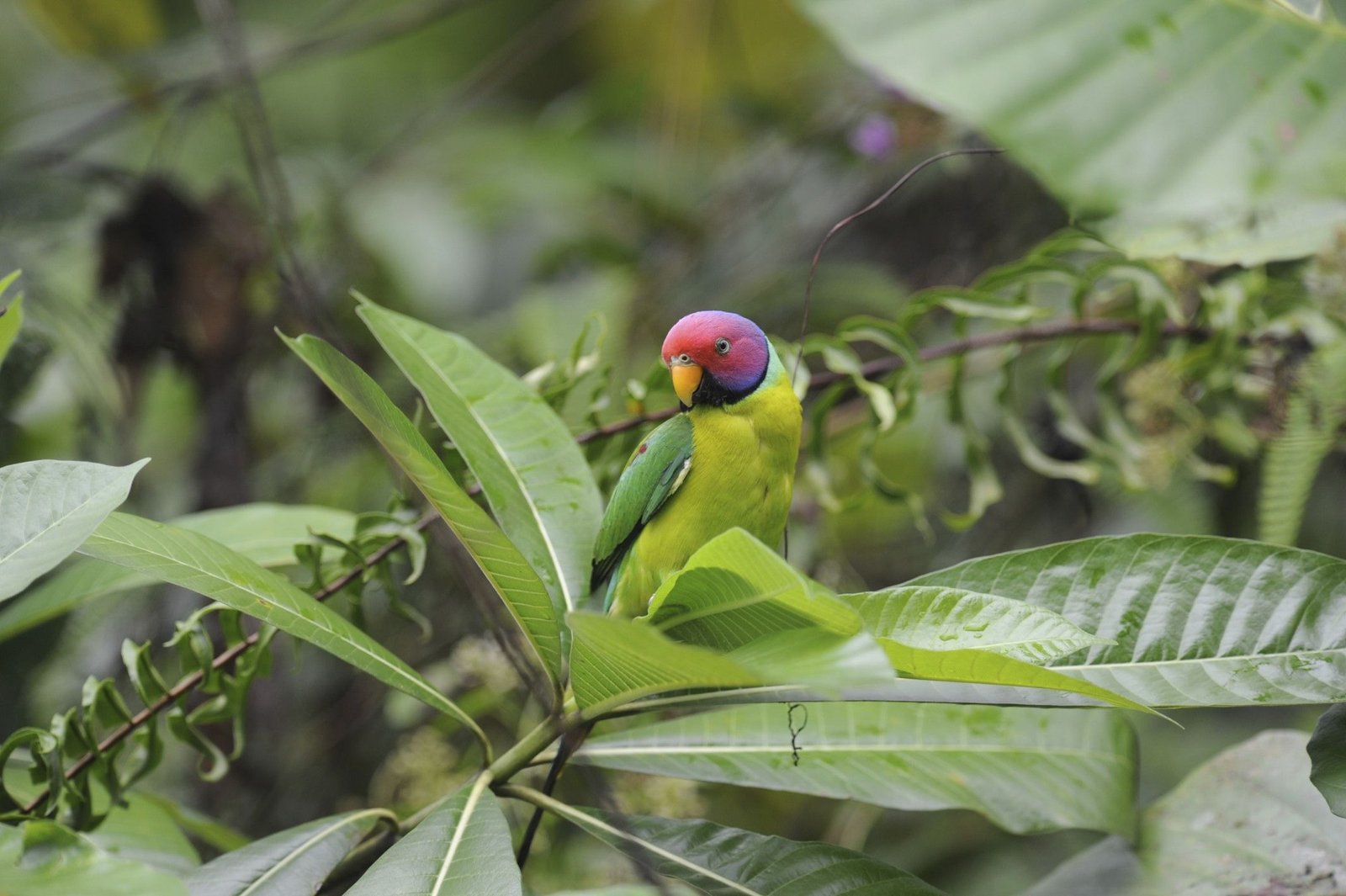The plum-headed parakeet is a gentle, social, and affectionate bird with their owners, making them a good choice for apartment living or close quarters with neighbors. They have relatively quiet personalities and can learn to mimic sounds and talk.
Plum-headed parakeets are native to India, Pakistan, Sri Lanka, and Bangladesh, where they thrive in woodlands and forested areas. They have a unique appearance, with males displaying vibrant plum-colored heads and females having dull blue or gray heads with a yellow collar.
In this species profile, we will explore the origins, temperament, colors and markings, and care requirements of the plum-headed parakeet.
:strip_icc()/nanday-parakeet-150149527-5a4c2b3bb39d0300379943d8.jpg)
Temperament And Behavior
Plum-headed parakeets are known for their gentle, social, and affectionate temperament towards their owners. They are relatively quiet birds, making them suitable for those living in apartments or close to neighbors.
Personality Traits Of Plum-headed Parakeets
Plum-headed parakeets are known for their delightful personalities. These birds are generally gentle and affectionate with their owners, forming strong bonds of trust and love. They are social creatures and thrive on interaction and attention. Plum-headed parakeets have a curious nature and are always exploring their surroundings. They are intelligent and can quickly learn new tricks and behaviors.
These parakeets have a playful and mischievous side, often engaging in antics that will bring a smile to any bird lover’s face. Their charming personalities make them popular pets among bird enthusiasts.
Ability To Talk And Mimic
Plum-headed parakeets have the exceptional ability to learn to talk and mimic sounds. While they may not be as proficient as some other parrot species, they can still pick up words, phrases, and simple tunes with adequate training and patience. Their vocalizations are generally soft and melodious, adding a pleasant touch to their already charming demeanor.
Owners of plum-headed parakeets often enjoy teaching them new words and engaging in conversations with their feathered friends. The ability to interact verbally with these parakeets adds another layer of enjoyment and companionship to the human-bird relationship.
Social Behavior
Plum-headed parakeets are highly social birds and thrive in the company of their human companions and other birds. They appreciate the quality time spent with their owners and enjoy being included in the daily activities of the household. These parakeets are known to be gentle and loving, often cuddling up to their trusted humans.
While they are generally friendly, plum-headed parakeets can be a bit reserved around strangers. It may take some time for them to warm up to new people, but with patience and consistent interaction, they can become more comfortable.
Plum-headed parakeets also enjoy the company of other birds and can live harmoniously in aviaries or multi-bird households. Their sociable nature makes them a great choice for bird owners who want to provide their feathered friends with plenty of social stimulation and companionship.
In conclusion, plum-headed parakeets are delightful birds with charming personalities. They enjoy social interaction, have the ability to talk and mimic, and form strong bonds with their owners. If you’re looking for a bird that will bring joy and companionship into your life, the plum-headed parakeet may be an excellent choice.

Care And Conservation
The plum-headed parakeet is a gentle and social bird, known for its affectionate nature towards its owners. With their relatively quiet nature, they are a suitable choice for bird owners living in apartments or places with neighbors nearby.
Habitat And Natural Environment
The Plum-Headed Parakeet, scientifically known as Himalayapsitta cyanocephala, is native to the Indian subcontinent. These beautiful birds are commonly found in the foothills of the Himalayas, as well as in Nepal, Bhutan, and parts of Bangladesh. They inhabit a variety of forested areas, including tropical, subtropical, and montane forests. Plum-headed parakeets are highly adaptable and can also be found in urban areas, parks, and gardens.
In their natural habitat, these parakeets are typically found in small flocks and exhibit strong social bonds. They are partial migratory birds, moving between different elevations depending on the season. During breeding season, which occurs from February to June, they can be found at higher elevations. However, during the non-breeding season, they descend to lower altitudes in search of food and shelter.
Feeding And Husbandry
Plum-Headed Parakeets have a diverse diet consisting of various fruits, berries, seeds, nuts, and flowers. In the wild, they forage for food in trees and shrubs, using their strong beaks to crack open seeds and nuts. In captivity, it is important to provide them with a balanced and nutritious diet to ensure their health and well-being.
A suitable diet for a pet Plum-Headed Parakeet includes fresh fruits such as apples, grapes, and papayas, as well as vegetables like carrots and leafy greens. Additionally, a quality parakeet seed mix can be offered as a supplement. It is important to avoid feeding them avocado, chocolate, caffeine, and any toxic foods for birds. Providing fresh water for drinking and bathing is crucial, as plum-headed parakeets love to splash around and keep themselves clean.
When it comes to their husbandry, providing a spacious cage with plenty of room for flying is essential. The cage should include perches of different sizes and materials to promote foot health. It is also important to provide them with toys and mental stimulation to prevent boredom. Regular cleaning of the cage and providing a safe and comfortable environment are vital aspects of their care.
Conservation Status
The Plum-Headed Parakeet is classified as “Least Concern” by the International Union for Conservation of Nature (IUCN). However, their population is gradually decreasing due to habitat loss and fragmentation caused by deforestation and urbanization. In some regions, they are also caught in the illegal bird trade. Conservation efforts, such as protected areas and awareness campaigns, are necessary to ensure the survival of this species in the wild.
To support the conservation of plum-headed parakeets, individuals can contribute by not engaging in the illegal trade of these birds and by raising awareness about their conservation needs. Additionally, planting native trees and providing suitable nesting spaces in gardens and parks can help create a hospitable environment for these beautiful parakeets.
In conclusion, understanding the natural habitat, feeding requirements, and conservation status of plum-headed parakeets is crucial for their care and well-being. By providing a suitable environment and contributing to their conservation, we can ensure the continued existence and enjoyment of these remarkable bird species.

Frequently Asked Questions For Plum-headed Parakeet: Bird Species Profile
What Is The Personality Of A Plum-headed Parakeet?
Plum-headed parakeets are gentle, social, and affectionate with their owners. They can be reserved with strangers. They are relatively quiet, making them suitable for apartment living.
Can Plum-headed Parakeet Talk?
Yes, plum-headed parakeets can talk when kept in captivity. They can learn to mimic beeps and short whistling tunes, and can become proficient at talking.
Are Plum-headed Parakeets Rare?
Plum-headed parakeets are quite rare, especially in the President’s Estate, where they were last spotted. They have a gentle and social personality, making them great for bird owners in apartments. They can mimic beeps and short whistling tunes, and can learn to talk.
What are the distinguishing characteristics of parakeets?
Parakeets are small, slender birds with long, tapered tails. They come in vibrant colors like green and yellow with black scalloped markings on their back, nape, and wings. They are generally social and affectionate with their owners but can be wary of strangers.
They make relatively quiet pets suitable for apartment living.
Conclusion
The plum-headed
With their vibrant colors and unique markings, these birds make a beautiful addition to any bird lover’s home. Care for these parakeets involves providing proper attention, diet, and habitat to ensure their well-being. Overall, the plum-headed parakeet is a fascinating and captivating bird species that brings joy to its owners.


